Development Of Dentition And Occlusion
Question 1. Differentiate between Leeway space and Freeway space.
Or
Briefly differentiate between freeway space and Leeway space.
Answer.
Briefly differentiate between freeway space and Leeway space.
Answer.
Leeway Space
The combine mesiodistal width of permanent canine and premolar is usually less than that of deciduous canines and molars. The surplus space is called as Leeway space of Nance.
- The amount of Leeway space is greater in mandibular arch than in maxillary arch.
- It is 1.8 mm in maxillary arch and 3.4 mm in mandibular arch.
- This excess space is available after exchange of deciduous molars and canines is utilized for mesial drift of mandibular molars to establish class I molar relationship.
Read And Learn More: Orthodontics Question And Answers
Freeway Space
Freeway space is defied as gap existing between maxillary and mandibular teeth occlusal rims when mandible is in physiological rest position. The space is wedge shaped. It varies from to 2–4 mm.
Clinical Significance
- It prevents fatigue of masticatory apparatus.
- It prevents clicking due to premature contacts of teeth.
- It prevents soreness of basal seat tissue.
- It prevents alveolar bone resorption.
- It prevents TMJ integrity.
- It helps in establishing proper phonation.
Question 2. Write short note on ugly duckling stage of dentition.
Or
Write short note on Broadbent phenomenon.
Or
Write short note on ugly duckling stage.
Or
Write short answer on ugly duckling stage of occlusion.
Or
Write short answer on ugly duckling stage.
Answer.
Or
Write short note on Broadbent phenomenon.
Or
Write short note on ugly duckling stage.
Or
Write short answer on ugly duckling stage of occlusion.
Or
Write short answer on ugly duckling stage.
Answer.
- Ugly duckling stage is the transient form of malocclusion.
- It is also known as Broadbent phenomenon or physiological midline diastema
- It is known as ugly duckling stage since it represents a metamorphosis from an unaesthetic phase to an aesthetic phase.
- Ugly duckling stage occurs from 7 to 11 years of age.
- As the canine erupts they impinge over the roots of lateral incisors.
- Erupting pressure of canines leads the lateral incisor to erupt in oral cavity with distal divergence of crown.
- As the lateral incisor erupts completely the erupting pressure from the canine persist and is transmitted to central incisors which leads to the divergence of crown and convergence of roots towards midline.
- This effect causes midline diastema, which is self corrected later on.
- The temporary space which exists between central incisors and at times between central as well as lateral incisors closes spontaneously as canine come into occlusion. This is known as ugly duckling stage.
Clinical Importance
- If attempt is made to close this diastema, deleterious effects occur, i.e. canine get deflected from its path of eruption and the apex of lateral incisor get damaged.
- Total closure of diastema should not be done more than 2 mm.

Question 3. Write short note on incisor liability.
Answer.
Answer.
Incisor Liability
- Incisor liability was explained by Warren Mayne in 1969.
- The permanent incisors are larger than their primary incisors and thus require more space for their alignment “The difference between space available and space require is called incisor liability”.
- Favorable incisor liability occurs when primary dentition is an open dentition while unfavorable incisor liability occurs in closed dentition.
- Value of incisal liability in maxillary arch is 7 mm while it is 5 mm in mandibular arch.
- Various factors are responsible for the alignment of incisors, i.e.
- Interdental space: In primary dentition the space is present which help in alignment of incisors. Primate space is also used.
- Intercanine width: At the time of eruption of permanent incisor there is increase in the intercanine arch width which is 3–4 mm.
- Labial eruption of incisors: Primary incisors remain in uprighting position while the permanent incisors which replace them remain in labially proclined position. This causes the erupting permanent incisors to place them in a wider arch.
Question 4. Write short note on flush terminal plane.
Answer. The mesiodistal relation between the distal surface of upper and lower second deciduous molar is called the terminal plane.
Answer. The mesiodistal relation between the distal surface of upper and lower second deciduous molar is called the terminal plane.
- A normal feature of deciduous dentition is flsh terminal plane, where the distal surface of upper and lower second deciduous molars are in the same vertical plane.
- This is a normal feature of the deciduous dentition.
- Thus the erupting fist permanent molars may also be in a flush or end on relationship, for the transition of such an end on molar relation to a class I molar relation, the lower molar has to move forward by about 3 to 5 mm ,relative to the upper molar. This occurs by utilization of the physiologic spaces and Leeway space
- They are designated as the early and the late shift

Question 5. Write short note on Leeway space.
Or
Write short note on Leeway space of Nance.
Or
Write short answer on Leeway space of Nance.
Or
Write short note on Leeway space and its importance.
Or
Write short note on Leeway space and its significance.
Answer.
Leeway Space of Nance
The combine mesiodistal width of permanent canine and premolar is usually less than that of deciduous canines and molars. The surplus space is called Leeway space of Nance.
- The amount of Leeway space is greater in mandibular arch than in maxillary arch.
- It is 1.8 mm (0.9 mm in each side of arch) in maxillary arch and 3.4 mm (1.7 mm in each side of arch) in mandibular arch.
- This excess space is available after exchange of deciduous molars and canines is utilized for mesial drift of mandibular molars to establish class I molar relationship.

Importance/Significance of Leeway Space
- Presence of excessive Leeway space is a favorable feature, which provides for the mesial movement of the permanent molars.
- Leeway space in the mandibular arch is more than that of the maxillary arch. This is because the primary mandibular molars are wider than the primary maxillary molars. The Leeway space diffrential between the two arches cause the mandibular fist molar to move mesially relatively more than the maxillary fist molar. Such an arrangement causes a change in the molar relationship from end on in the early mixed dentition period to class I relation at the late mixed dentition period (late mesial shift.
- Leeway space defiiency may be seen in some individuals when size of unerupted premolars and permanent canine are larger than the space available.
Question 6. Describe development of dentition in detail.
Or
Describe development of occlusion from birth to 12 years of age.
Answer. Occlusion is defied as “the changing inter-relationship of the opposing surfaces of maxillary and mandibular teeth which occurs during movements of mandible and terminal full contact of the maxillary and mandibular dental arches”.
Periods of Occlusal Development
- Predental/Dentate period.
- Deciduous dentition period.
- Mixed dentition period.
- Permanent dentition period.
Predental/Dental Period
- Period from birth to the eruption of the fist deciduous teeth in oral cavity.
- In this period neonate does not have any teeth.
- It usually lasts for 6 months aftr birth.
- The alveolar ridge at this stage is called gum pad.
Gum Pad
The alveolar processes at the time of birth are known as gum pads.
- The gum pads are pink, fim and are covered by a dense layer of firous periosteum.
- They are horseshoe, shaped in the maxilla and U-shaped in mandible.
- The gum pads develop in two parts – the labio-buccal portion and the lingual portion.
- The labio-buccal portion develops before the lingual portion.
- The two portion of the gum pads are separated from each other by a groove called dental groove (Dental groove is the site of origin of the dental lamina).
- The gum pads are divided into 10 segments by 10 grooves called transverse groove.
- Each segment contains one developing deciduous tooth sac.
- The transverse groove between the canine and first deciduous molar segment is called lateral sulcus.
- The lateral sulcus of the mandibular arch is normally more distal to that of the maxillary arch. The gum pads meet only at the lateral sulcus on other part the gum pads do not meet, they help in feeding of infant.
Gingival Groove
Gingival groove separates the gum pad from palate in maxillary arch and from flor of the mouth in lower arch.
- The gum pads meet only at the lateral sulcus on other part the gum pads do not meet, they help in feeding of infant.
- When the upper and lower gum pads are approximated there is a complete overjet all around. This space is occupied by tongue resulting in tongue thrust.
- The greater the anterior-posterior dimension of the gum pads, the greater the possibility of the child developing malocclusion.
Deciduous Dentition Period
Deciduous dentition period extend from 6 months to 6 years of postnatal life.
Primary teeth begin to erupt at age of 6 months and is completed by 2 ½ to 3 ½ years of age when second deciduous molars come into occlusion.
Eruption sequence of deciduous dentition is A – B – D – C– E.
Various Normal Features of an Ideal Occlusion in Deciduous Dentition
It is good as the space in between the teeth can be utilized for adjustment of permanent successors which are always larger in size from deciduous dentition.
These spaces are of two types:
- Primate.
- Physiological.
Primate Space/Simian Space/Anthropoid Space/Baum Space
- Primate space present between lateral incisor and canine in maxilla (in maxillary arch this space is used up by permanent incisors which are more wider).
- In mandibular arch the primate space present between canine and fist molar (this space is used by permanent molar).
Physiological/Development Space
- These spaces are present in between the primary teeth and play an important role in normal development of the permanent dentition.
- The total space present may vary from 0 to 8 mm with average 4 mm in maxillary arch and 1 to 7 mm with average 3 mm in mandibular arch.
Shallow overjet and overbite
Ovoid arch form
Almost vertical inclination of anterior teeth
Flush Terminal Plane
The mandibular deciduous second molar is usually wider mesiodistally than the maxillary second deciduous molar giving rise to typical flush terminal plane relationship. When a line is drawn on distal surface of the upper second deciduous molar it falls along the distal surface of lower deciduous second molar. As the fist permanent molars erupt, they will be in end on molar relationship in the presence of complete deciduous dentition having a flush terminal plane. This relation develops into class I molar relationship following exfoliation of lower deciduous second molar, due to the mesial migration of the lower permanent fist molars.

Deep Bite
A deep bite may occur in the initial stages of development. The deciduous incisors are more vertical (than their successors). The lower incisal edge contact the cingulum area of the maxillary incisors, this is called deep bite.
- The deep bite is reduced due to:
- Eruption of permanent posterior teeth
- Attrition of incisors
- Forward and downward movement of mandible due to growth.

Mixed Dentition Period
The period during which both the primary and permanent teeth are in mouth. It ranges from 6 to 12 years
- The permanent teeth which erupt in place of deciduous teeth are called successional teeth.
- The teeth those erupt posteriorly to the primary teeth are called accessional teeth.
- The mixed dentition period classified into:
- First transitional period.
- Inter transitional period.
- Second transitional period.
First Transitional Period
Phases/Characteristic features:
- Emergence of fist permanent molar.
- Incisors transition (incisor liability).
- Establishment of occlusion.
Emergence of First Permanent Molar
- Mandibular fist molar is the fist permanent tooth to erupt at 6 years of age.
- Location as well as relationship of fist permanent molar depends on the distal surface relationship between maxillary and mandibular second primary molars.
- First permanent molars are guided in the dental arch by distal surface of second deciduous molar.
- Mesiodistal relationship between the distal surfaces of maxillary and mandibular second primary molars can be of three types viz:
-
- Flush terminal plane: Distal surface of upper and lower second primary molar are in the one vertical plane. This is known as flsh or vertical terminal\ plane. It is the normal feature of deciduous dentition. So the erupting fist permanent molars can also be in flsh or end on relationship. For transition of this end on molar relationship to Class I molar relation, lower molar should move forward by 3 to 5 mm relative to upper molar. This happens by utilizing of physiologic spaces and leeway space in lower arch and by the diffrential forward growth of mandible.
- Shif in the mandibular molar from flsh terminal plane to Class I relation occur by two ways i.e. early shift and the late shift
- Early shift: It occurs at the early mixed dentition period. Eruptive force of fist permanent molar is suffient to push deciduous fist and second molars forward in the arch to close primate space and establish a class I molar relationship. As this occurs early, this is known as early shift
- Late shift: As many of the children lack primate spaces and so erupting permanent molars are unable to move forward to establish class I relationship. In such cases, when second deciduous molar exfoliate, permanent molars drif mesially utilizing the leeway space. This occurs in late mixed dentition period and is known as late shift
Mesial step terminal plane
In some cases, if the lower deciduous second molar is more mesial than upper deciduous second molar, it gives rise to a mesial step. This lead to a class I molar relationship. This mesial step terminal plane occurs because of early forward growth of mandible. If diffrential growth of mandible in forward direction occurs it leads to class III molar relationship in the permanent dentition.
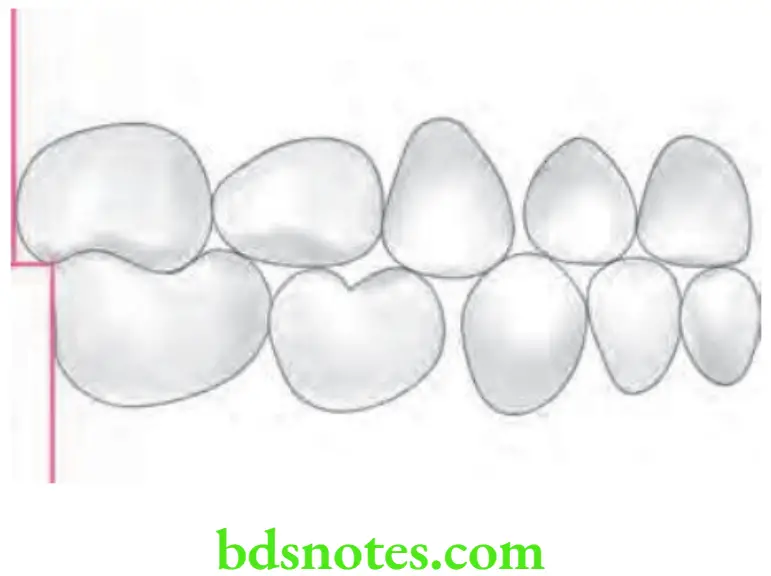
Distal step terminal plane
In some cases where the upper deciduous second molar is ahead of lower deciduous second molar, it gives rise to a distal step. This can lead to class II molar relationship in permanent dentition.
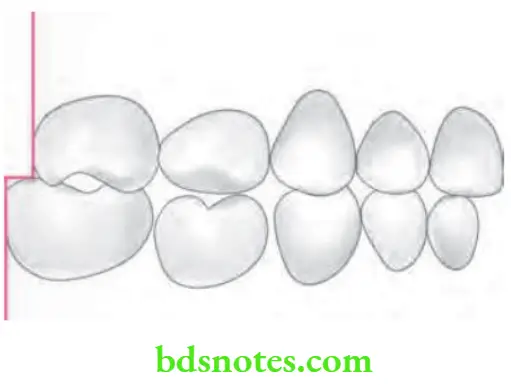
The exchange of incisors
- During the first transition period the deciduous incisors are replaced by permanent incisors.
- The permanent incisors are larger than the deciduous teeth.
- The diffrence between the amount of space needed for the accommodation of the incisors and the amount of space available for this is called “incisor liability”.
- The incisor liability is about 7 mm in the maxillary arch and about 5 mm in the mandibular arch.
- The incisor liability is overcome by:
- Utilization of physiologic space seen in primary dentition.
- Increase in intercanine width.
- Change in incisor inclination.
The primary incisors are more upright than permanent.
The angle between maxillary and mandibular incisors is about 150° in primary dentition whereas it is about 123° in permanent dentition.
Intertransitional period
It lasts about 1.5 years.
- This is a relatively quiet phase and no active tooth eruption is seen.
- This phase containing both set of dentition.
- Four permanent incisors, lef and right permanent fist molars.
- Deciduous canine and molars.
Second transitional period
This period is characterized by the replacement and alignment of the deciduous molars and canines by premolars and permanent cuspids.
The features of second transitional period are:
- Leeway space of Nance.
- Ugly duckling stage.
Leeway space of Nance
- The combined mesiodistal width of permanent canine and premolar is less than deciduous canine and molars.
- This is called Leeway space of Nance.
- It is 1.8 mm in maxillary arch and 3.4 mm in mandibular arch.
- This space is utilized by mandibular molars to establish class I relationship.
Ugly duckling stage
Ugly duckling stage is also known as Broadbent’s phenomenon or physiological midline diastema. Ugly duckling stage occurs from 7 to 11 years of age. As the canine erupts they impinge over the roots of lateral incisors. Erupting pressure of canines leads the lateral incisor to erupt in oral cavity with distal divergence of crown. As the lateral incisor erupts completely the erupting pressure from the canine persist and is transmittd to central incisors which leads to the divergence of crown and convergence of roots towards midline. This effect causes midline diastema, which is self corrected later on. The temporary space which exists between central incisors and at times between central as well as lateral incisors closes spontaneously as canine come into occlusion. This is known as ugly duckling stage.
Permanent Dentition Period
The entire permanent dentition is formed within the jaws aftr birth except for the cusps of fist molar.
The sequence of eruption for maxillary arch is 6-1-2-4- 5-3-7-8- and in mandibular arch 6-1-2-3-4-5-7-8.
- Some changes that can be seen in permanent dentition are:
- Horizontal overbite decreases.
- Dental arches become shorter.
- Vertical overbite decreases up to the age of 18 years by 0.5 mm.
- Overjet decreases by 0.7 mm between 12 and 20 years of age.
Question 7. Write short note on Andrew’s six keys to normal occlusion.
Or
Write about factors responsible for development of normal occlusion.
Or
Briefly discuss Andrew’s keys of occlusion.
Or
Write short note on six keys for normal occlusion.
Or
Write briefly on Andrew’s six keys of normal occlusion.
Or
Discuss Andrew’s keys to occlusion.
Or
Write short note on 6keys for normal occlusion.
Or
Write short note on Andrew’s six keys of occlusion.
Or
Write short note on keys to normal occlusion
Answer. Lawrence F Andrew’s six keys of normal occlusion are:\
- Key l: Molar Relationship (lnter-arch Relationship).
- Key 2: Crown Angulations (Mesiodistal Crown Angulations/Mesiodistal Tip).
- Key 3: Crown Inclination (Labiolingual Crown Inclination, the Labiolingual or Buccolingual Torque).
- Key 4: Absence of Rotations.
- Key 5: Presence of Tight Contacts.
- Key 6: Flat Occlusal Plane.
Key 1: Molar Relationship (Interarch Relationship)
- Mesiobuccal cusp of the maxillary fist permanent molar falls within the groove between the mesial and middle cusps of the mandibular fist permanent molar.
- Distal surface of the distal marginal ridge of the maxillary first permanent molar contacts and occludes with the mesial surface of the mesial marginal ridge of the mandibular second permanent molar.
- Mesiolingual cusp of the maxillary fist permanent molar seats in the central fossa of the mandibular fist permanent molar.
Key 2: Crown Angulations (Mesiodistal Crown Angulations/Mesiodistal Tip)
In the normal occluded teeth, the gingival portion of the long axis of each crown is distal to the occlusion portion of that axis. The degree of the angulation varies with each tooth type.
Key 3: Crown Inclination (Labiolingual Crown Inclination, Labiolingual or Buccolingual Torque)
- Angle between a line is 90° to the occlusal plane, as well as a line tangent to the middle of the labial or the buccal surface of clinical crown, which is referred to as crown inclination.
- Lingual crown inclination occurs in maxillary and mandibular posteriors.
- Positive or labial inclination in maxillary incisors.
Key 4: Absence of Rotations
- In order to achieve correct occlusion, none of the teeth should be rotated, rotated molars and premolars occupy more space in the dental arch than normal.
- Rotated incisors may occupy less space than those correctly aligned.
- Rotated canines adversely affct esthetics and may lead to occlusal interference.
- There should be absence of rotation in both of the dental arches to be called as normal occlusion.
Key 5: Presence of Tight Contacts
There should be tight contacts and absence of any spacing. Tight contacts are an essential part to maintain the integrity of any arch form, especially the dental arches.
Key 6: Flat Occlusal Plane
- Curve of Spee should be relatively slight or flt.
- Vertical distance between any tooth and a line joining the most prominent cusp tip of the mandibular molar and central incisor (curve of Spee) should not exceed 1.5 mm.
- An excessive curve of Spee restricts the amount of space available for the upper teeth, which must then move toward the mesial and distal, thus, preventing correct intercuspation.
Question 8. Give the eruption date and sequence of eruption of permanent teeth. Discuss various self correcting anomalies.
Answer.
Answer.
Eruption Age of Permanent Teeth

Eruption Sequence of Permanent Teeth
In Maxilla
6-1-2-4-3-5-7-8 Or 6-1-2-4-5-3-7-8
In Mandible
(6-1)-2-3-4-5-7-8 Or (6-1)-2-4-3-5-7-8
Self Correcting Anomalies
- Predentate period
- Retrognathic mandible
- Anterior open bite
- Infantile swallowing pattern
- Primary dentition:
- Deep bite
- Flush terminal plane
- Spacing
- Increased overjet
- Mixed dentition:
- Deep bite
- Mandibular anterior crowding
- Ugly duckling stage
- End on relation
Increased Overjet
Excessive incisal overjet is often observed in deciduous dentition. 72% of children exhibited an increased overjet in a study conducted by Foster. Excessive overjet usually gets corrected later by forward growth of the mandible.
Anterior Open Bite
When there is no overlap of upper anteriors over the lower anterior such condition is known as anterior open bite. It is corrected during the eruption of primary incisors.
Retrognathic Mandible
It gets corrected with cephalocaudal growth and diffrential growth of mandible.
Infantile Swallowing Pattern
It get corrected with initiation of function at about 18 months of age.
Deep Bite
- An increased overbite is usually seen in the initial stages of development with the deciduous mandibular incisors contacting the cingulum area of the deciduous maxillary incisors in centric occlusion. Deep bite may be due to the fact that the primary incisors are more vertically placed than the permanent incisors.
- The ideal position of the deciduous incisors has been described as being more vertical than the permanentincisors, with a deeper incisal overbite.
This Deep Bite Later Gets Self-corrected By:
- Attrition of incisors.
- Eruption of deciduous molars
- Differential growth of the alveolar processes of jaws.
End on Relation
In presence of flush terminal plane the fist permanent molars assume cusp to cusp or end on molar relationship as they erupt distal to second primary molars. It gets corrected during late mesial shift
Question 9. Briefly differentiate between Primate and Leeway space.
Answer.
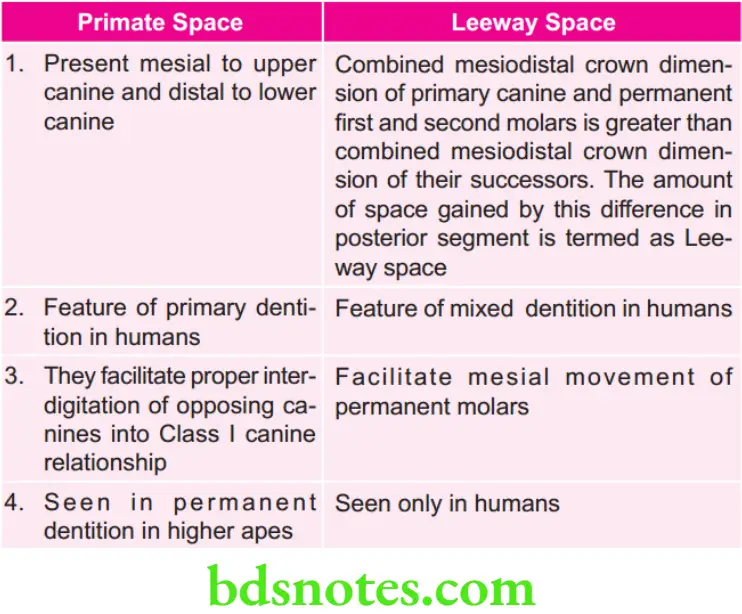
Question 10. Briefly differentiate between incisal liability and Leeway space.
Answer.
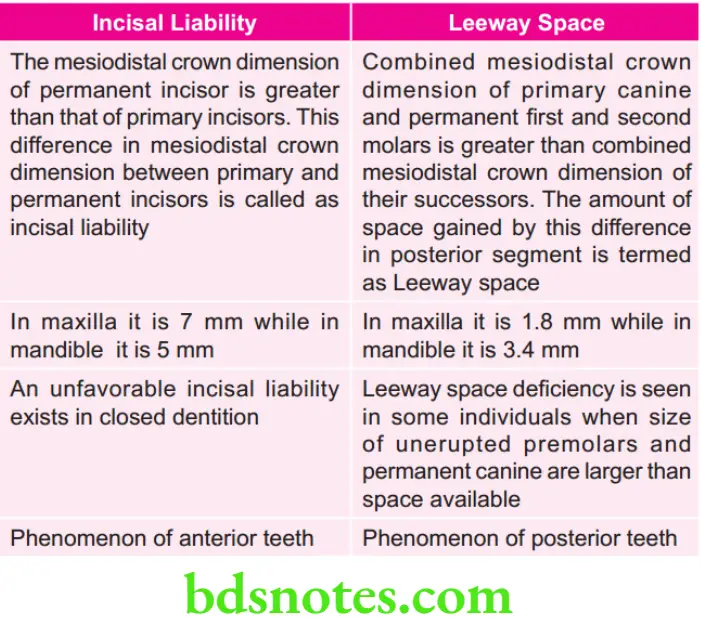
Question 11. Discuss in brief sequence of eruption of teeth.
Answer.
Eruption Sequence of Primary Teeth
- Eruption starts at 6 to 7 months after birth.
- Eruption get delayed by 4 to 10 months is normal.
- By 3 years of age the occlusion of deciduous dentition is completely established and dental arches remain relatively constant with no significant changes up to 6 years of age.
- Lower central incisors are fist teeth to erupt followed by upper central incisors. Usually the lateral incisor, fist molar and canine tend to erupt earlier in maxilla than in mandible. Deciduous dentition show following order of eruption.

Question 12. Describe the development of dentition from 6 years to 12 years with special emphasis on transient malocclusion.
Answer. Dentition from 6 years to 12 years comes under the mixed dentition period.
Transient Malocclusion from 6 to 12 Years of Age
It consists of the conditions which appear as malocclusion at some specific time, but as time passes and with the normal growth such conditions get self corrected without any treatment.

Question 13. Describe in detail development of dentition in mixed dentition stage. Write role of dentist in interception of early signs of malocclusion in this stage.
Answer.
Role of Dentist in Interception of Early Signs of Malocclusion in Mixed Dentition Stage
Following are the procedures to be undertaken by the dentist in interception of early signs of malocclusion in mixed dentition stage:
- Serial extraction.
- Correction of developing crossbite.
- Control of abnormal oral habit.
- Proximal stripping.
- Correction of occlusal interferences.
- Interception of skeletal malrelation.
- Space regaining.
- Muscle exercises.
- Removal of soft tissue and bony barriers.
Serial Extraction
Eruption of permanent incisors in early mixed dentition may result in crowding in patients with severe tooth size-arch length discrepancy of 8-10 mm or more. Such patients would ultimately require extraction of four premolars to provide space for proper alignment of remaining permanent teeth. Rationale of serial extraction procedure is to intercept malocclusion at early mixed dentition period by extracting certain primary and permanent teeth and guiding the eruption of remaining permanent teeth in best possible occlusion.
Correction of Developing Crossbite
Anterior crossbite should be intercepted and treated at an early stage, if left untreated it can cause severe skeletal malocclusion. Dentoalveolar anterior crossbites are best treated by tongue blade therapy. Skeletal anterior crossbites are best treated by myofunctional appliances. Functional anterior crossbite is treated by eliminating occlusal prematurities.
Control of Abnormal Oral Habits
Oral habits such as thumb sucking, tongue thrusting, etc should be intercepted by the dentist at age of 3.5 years to 4.5 years. Oral habits are intercepted by removal orthodontic appliance such as oral screen or by fixed orthodontic appliance such as fixed crib.
Proximal Stripping
Proximal stripping of first and second deciduous molars is required to facilitate eruption of adjacent succedaneous permanent teeth into normal occlusion.
Correction of Occlusal Interferences
Occlusal interferences can deflect mandible anteriorly, laterally or posteriorly. So as soon as occlusal prematurities are ruled out by dentist, they should be intercepted by reduction of crown height by pear-shaped stone in center angled handpiece.
Interception of Skeletal Malocclusion
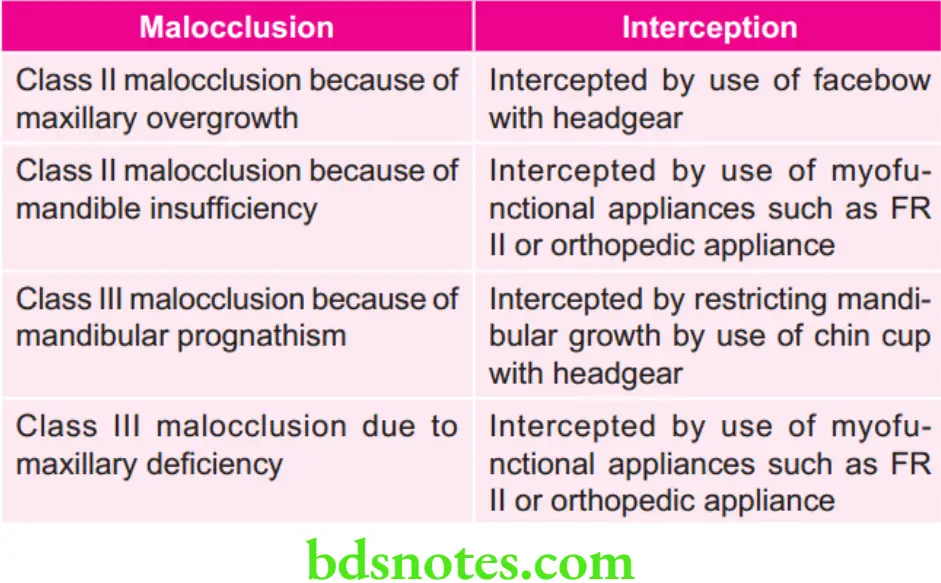
Space Regaining
This can be done by using following appliances, i.e.
- By using cantilever spring: Space lost due to mesial drifting of permanent molar as well as distal drifting of deciduous fist molar when deciduous molar get lost prematurely, this is regained by use of two finger springs.
- By using jack screw: Space is regained by use of removable orthodontic appliance which has jack screw in a way which increases the arch length which is obtained by distalization of molar.
- Gerber space regainer: It is an orthodontic molar band which is used for the tooth which has to be distalized. It consists of a U-shaped hollow tubing.
Removal of Soft Tissue and Bony Barrier to Enable Eruption of Teeth
It involves excision of soft tissue as well as removal of bone covering the crown of unerupted tooth for making the space so that tooth can erupt easily.
Question 14. Write short note on self correcting malocclusions.
Answer.


Question 15. Write short note on physiological vs primate spaces.
Answer.
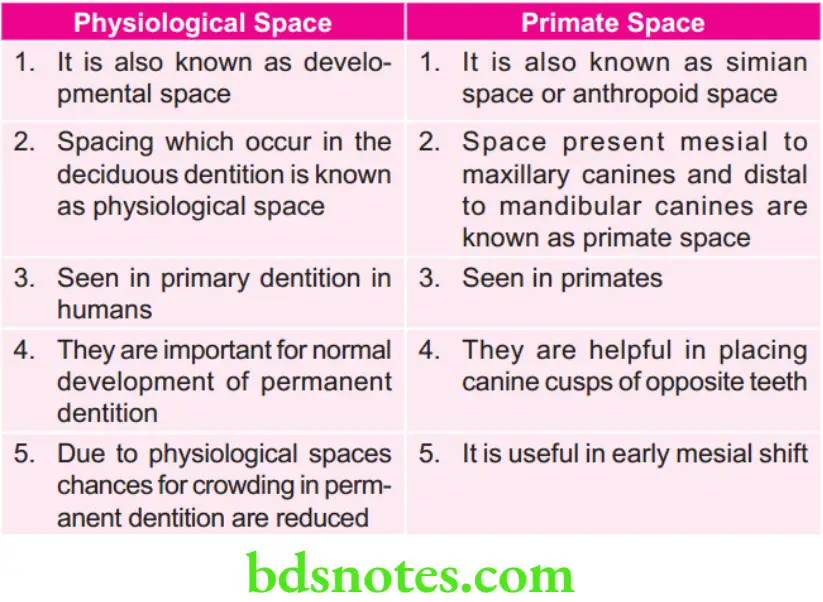
Question 16. Write short note on natural bite openers.
Answer. The moment first permanent molar erupts the associated deep bite gets relieved and this is known as natural bite opener.
- According to Schwartz, there are three periods of physiologic raising of the bite, with the eruption of the fist permanent molars at 6 years, with the eruption of the permanent second molars at 12 years and with the eruption of the third molars at around the age of 18 years.
- As the upper and lower fist permanent molars erupts, the pad of tissue overlying them creates a premature contact.
- Proprioceptive response conditions the patient against biting on this natural “Bite opener” and thus the deciduous teeth anterior to the fist permanent molar area erupt, reducing the overbite, this is physiologic bite opening.
Question 17. Enumerate Andrew’s Keys of occlusion. Describe the concept of normal occlusion.
Answer.
Andrew’s Keys of Occlusion
- Key l—Molar Relationship (lnter-arch Relationship).
- Key 2—Crown Angulations (Mesiodistal Crown angulations/Mesiodistal Tip).
- Key 3—Crown Inclination (Labiolingual Crown inclination, the Labiolingual or Buccolingual Torque).
- Key 4—Absence of Rotations.
- Key 5—Presence of Tight Contacts.
- Key 6—Flat Occlusal Plane.
Concept of Normal Occlusion
- Normal occlusion is defied as the contact of the upper and lower teeth in the centric relationship.
- Lawrence F Andrew worked on 120 non-orthodontic models based on which he had discovered six keys of normal occlusion.
Question 18. Describe development of occlusion from 6 years to 12 years of age. Discuss its application in orthodontic patient management.
Answer. Dentition from 6 to 12 years of age comes under mixed dentition period.
For development of occlusion refer to the heading mixed dentition period of Ans 6 of same chapter.
Application of Development of Occlusion from 6 to 12 Years of Age in Orthodontic Patient Management
Since dentition from 6 to 12 years of age is mixed dentition and malocclusions occurring at this period of time are self correcting, so orthodontist should keep in mind the self correcting malocclusions at this period of time.
Following are the Self correcting malocclusions and their corrections, which one should consider during orthodontic patient management from 6 to 12 years of age.
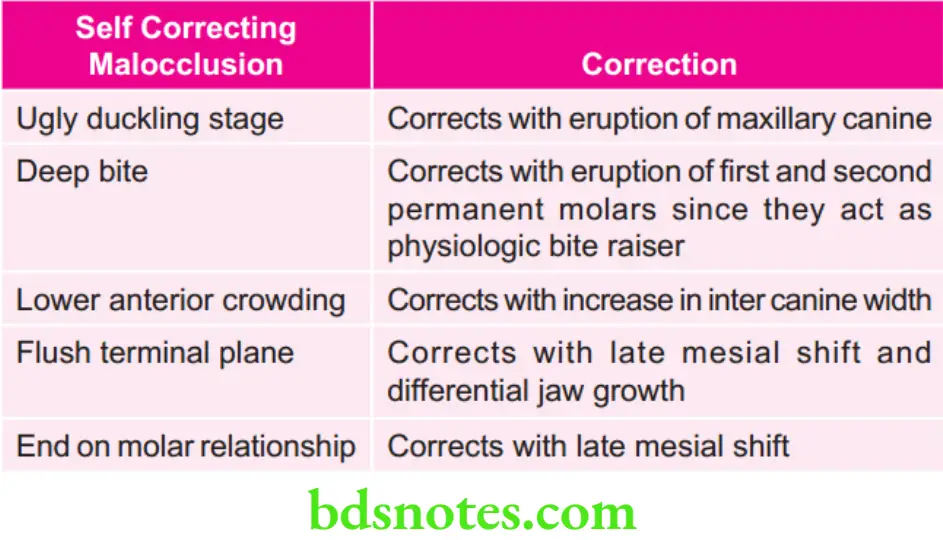
Question 19. Write short answer on physiologic bite opening.
Answer. According to Schwarz, there are three periods of physiologic bite opening i.e. with eruption of:
- First permanent molars at age of 6 years
- Second permanent molars at age of 12 years
- Third permanent molars at age of 18 years
Eruption of First Permanent Molars
- As first permanent molars erupt, pad of tissue overlying them creates a premature contact.
- Proprioceptive responsive conditions the child against biting on natural bite opener and thus the deciduous teeth anterior to fist permanent molar erupt, reducing the overbite.
- The maxillary and mandibular fist molars show different paths of eruption i.e. maxillary buccal and distal while the mandibular is lingual and mesial.
Eruption of Second Permanent Molars
- Eruption of second molar teeth occurs shortly after the appearance of second premolar.
- Gingival pads overlying second molar contact prematurely again, blocking the open bite anteriorly, allowing the eruption of teeth anterior to second molars. This is second physiologic bite opener.
- The reduction in overbite is minimum and is variable, being greater in some cases and less in others, but it is a phenomenon which occur so frequently that it should be watched.
Eruption of Third Permanent Molars
- Long axis of developing third molar is obliquely directed towards the tongue in midplane at an angle of from 550 to 700.
- This inclination becomes less obtuse between the ages of 12 and 16 years, but occlusal surface is still lingually inclined.
- Since the alveolar process curve lingually at the point of juncture with anterior border of ramus, third molar may frequently have enough room to erupt. These are the third physiologic bite opener.

Leave a Reply